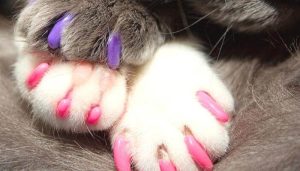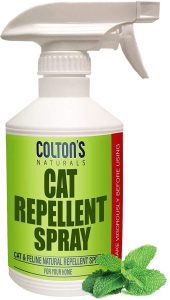Article Written by staff member: Emily Gray
There is a worldwide debate on whether or not declawing cats should be banned. Most people question how humane the procedure is. An Onychectomy, or the declawing procedure, is an amputation of the last bone in each toe of a cat’s paws. You may not realize how detrimental a cat’s claws are to their everyday life. Cats use their claws to walk, scratch, release stress, affirm territory, exercise muscles, and so many more activities that make a cat, a cat. Cats are believed to scratch over 3,000 times in their lifetime. Declawed cats are witnessed going through the motions a clawed cat would go through, but without claws a cat misses out on the benefits of scratching. Scratching helps cats deposit their scent, keep nails short and shed claw sheaths, stretch and release “feel good” hormones, and relieve stress. Unlike most mammals that walk on their heels and soles, cats walk on their toes. Removing a cat’s claws can completely change their gait, make walking painful and change the way they live their lives.

In addition to changed gait, there are many negative effects of declawing cats that make the procedure an inhumane process. Declawed cats experience extreme acute pain from the declawing procedure. In the short term, postoperative declawed cats may experience issues related to lameness, chewing at the paws, paw swelling, nail regrowth, excessive bleeding, infection, and persistent pain. This develops into long term pain that declawing can inflict. Physical issues such as chronic pain, arthritis, bone spurs and regrowth, nerve damage, and weight gain can result from declawing. Furthermore, declawing can lead to cats developing various behavioral problems. Cats generally reserve biting as a last resort defense mechanism. With other options, such as claws, removed, a cat may be left with no choice but to bite if they feel threatened. The persistent pain cats feel can be made worse by granules of litter becoming stuck within their paw pads. Declawed cats are at risk of associating their litter box with pain, as litter may become trapped in their already painful paw pads. This association may lead the cat to avoid the litter box entirely so as to not hurt their feet more. Declawed cats are at higher risk of barbering, or over grooming. Though many studies have found significantly higher barbering rates in declawed cats than in clawed cats, the reason for this expression of behavior is unknown. Some plausible explanations exist such as relieving stress or expressing pain.
So why is it that people declaw cats?
Some individuals may try to justify the declawing process for reasons such as elderly owners with thin skin, spread of zoonotic diseases through cat scratches, saving furniture, or trimming excess nails on a polydactyl cat. Despite these reasons, there are many possible

solutions to this epidemic. Education on the concept of declawing is a key component in helping owners make the proper decision for their lifestyle as well as the well-being of their cat. On average around 20% of cat bites are said to become infected, and are statistically much more likely to spread zoonotic diseases than cat scratches. In order to hinder a cat’s ability to tear things while still giving them ample use of their claws, one option is claw caps. Claw caps are plastic covers that can painlessly prevent damage to furniture and skin, and are applied using a glue on the cat’s nails to adhere it. Giving cats scratching posts in optimum locations and made of various materials will give them an outlet to express themselves. Sprays exist as both attractants and deterrents. Using attractants on scratching posts can encourage a cat to use their claws in designated areas, and using deterrents can discourage a cat from scratching in areas  where they are not supposed to scratch. Slipcovers and sofa savers can be a quick solution to cover anything that the cat is not supposed to scratch. Regular nail trims can be done at home or by a veterinarian in order to prevent long nails from snagging and will limit the cat from having to wear down their nails on their own by scratching. There are many humane alternatives to feline declawing.
where they are not supposed to scratch. Slipcovers and sofa savers can be a quick solution to cover anything that the cat is not supposed to scratch. Regular nail trims can be done at home or by a veterinarian in order to prevent long nails from snagging and will limit the cat from having to wear down their nails on their own by scratching. There are many humane alternatives to feline declawing.
How does declawing affect shelter cats?
Declawed cats who are surrendered to shelters are significantly more fearful and one study found that declawed cats have a longer average stay than cats that are not declawed. Declawing bans in countries such as Europe have not seen a significant increase in cat surrenders since the declawing ban has been implemented. We see these statistics every day at Friendship APL. In a 2 year period from January 5, 2021 to January 5, 2023, Friendship APL saw 88 declawed cats arrive, ranging from ages 4 months to 16 years old. Of these declawed cats, 19 cats (21.6%) were returned to Friendship APL at least once. 11 declawed cats (12.5%) had a profile that mentioned “aggression”, while 10 declawed cats (11.4%) had a profile that mentioned “going outside of the litter box”. Of these cats, multiple experienced health problems associated with declawing, such as barbering or arthritic symptoms. Witnessing cats experience negative changes in quality of life after declawing, as well as educating oneself on the nature of declawing, brings the unnecessary nature of this elective procedure to light. The pain and trauma inflicted on cats that go through this procedure explains why more declawing bans are being implemented across the globe.




